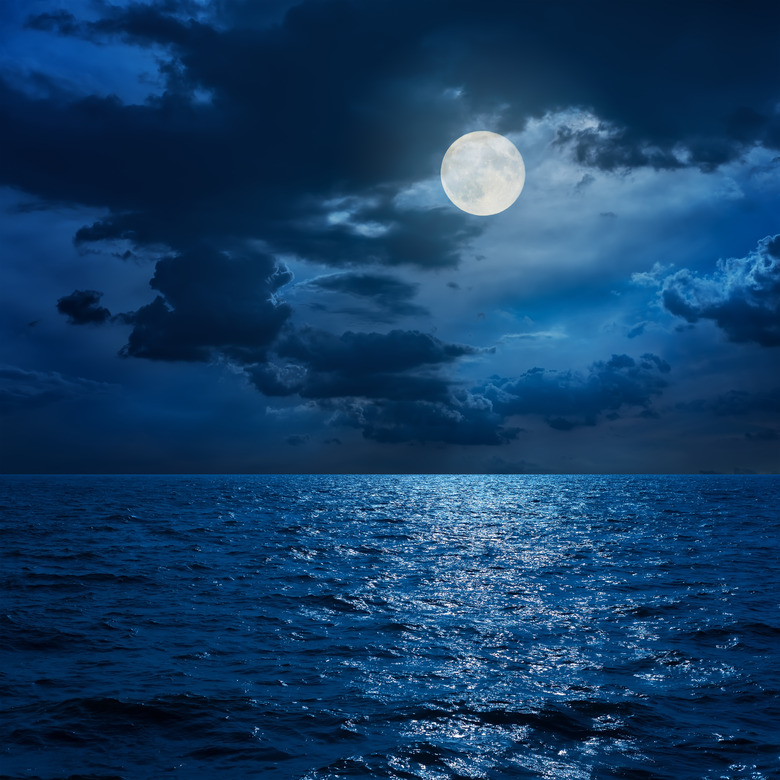When Is The Moon's Pull On Earth The Strongest?
The strength of lunar gravity is related to the moon's mass – which does not change – and the distance between the moon and the Earth. As the moon follows its elliptical orbit around the Earth, the distance between the two celestial objects increases and decreases. The moon's pull on Earth is strongest when they are nearest to each other.
TL;DR (Too Long; Didn't Read)
Gravitational pull is affected by mass and distance. Since the moon's mass does not change, the moon's distance between Earth and the moon is the main consideration for the strength of lunar gravity. The moon's pull on Earth waxes and wanes as the moon follows its elliptical orbit around the Earth, the distance between the two celestial objects increases and decreases. When they are nearest to each other, the moon is in the point of its orbit called the perigee, and its pull on Earth is the strongest.
On Earth, the moon's gravity primarily is manifested as high and low tides, as the water bulges toward the moon. The effects of lunar gravity are felt the most at the constantly changing spot on Earth that is directly beneath the moon, called the sub-lunar point. At most times of the year, the moon has a greater pull on Earth than the sun does, but this changes during the times of year when the Earth's orbit brings it closer to the sun. At these times, the sun's gravitational pull causes spring tides, and when these coincide with the moon's orbital perigee around the Earth, they are called perigean spring tides.
Earth exerts a gravitational pull on the moon 80 times stronger than the moon's pull on the Earth. Over a very long time, the moon's rotations created fiction with the Earth's tugging back, until the moon's orbit and rotational locked with Earth. This is called "tidal locking," and it explains why the same side of the moon always faces the Earth.
Effects of the Moon's Gravity
Effects of the Moon's Gravity
The moon's gravity reaches all parts of Earth, but its pull only noticeably affects large bodies of water, resulting in tides. The moon's gravitational pull is strongest at the sub-lunar point, which is the point on the Earth where the moon is directly overhead. This point is constantly changing, and follows the path of a circle around the planet each day. At this point, lunar gravity causes water to bulge toward the moon, creating high tides; it also pulls water to that spot from other areas, creating low tides.
Confusingly, the effect also occurs on the opposite, super-lunar side of the Earth where the moon is furthest away. This happens because the gravitational pull is stronger everywhere else, so while so much water is being pulled toward the sub-lunar point, the water at the super-lunar point is left behind to swell up and form tides.
Distance Affects Lunar Gravity
Distance Affects Lunar Gravity
The moon's "perigee" is the point in its orbit where it is nearest to the Earth. The moon's gravitational pull on Earth is the strongest when the moon is at the perigee, which results in greater tide variation than normal. This variation creates slightly higher high tides and slightly lower low tides. Conversely, the moon's "apogee" is the point in the lunar orbit when it is farthest from the Earth, which results in slightly lower tide variation than normal.
Adding the Sun's Gravity
Adding the Sun's Gravity
The moon's proximity to the Earth causes it to exert a stronger gravitational pull than the sun does on the Earth. However, the sun's effect is magnified at certain times of the year, when Earth's elliptical orbit brings it closer to the sun.
During this time, the alignment of the Earth, moon and sun creates spring tides that result in greater tidal variation. The most significant spring tides occur three or four times per year, when the Earth is closer to the sun and the moon is at its perigee, resulting in perigean spring tides. However, even under these conditions, high tides typically don't change enough to cause worrisome effects.
The Effects of Earth's Gravity on the Moon
The Effects of Earth's Gravity on the Moon
Earth exerts an gravitational effect on the moon that is 80 times stronger than the moon's pull on Earth. This massive gravitational pull caused the surface of the moon to bulge toward Earth, similar to how the moon causes large bodies of water on Earth to bulge.
Because the Earth and moon once rotated at different rates, the bulge on the moon was constantly rotating away from the Earth. However, the Earth's gravity tugged at this bulge as it rotated away, and the two opposing forces created significant friction that eventually slowed the moon into a synchronous orbit, which means the moon's rotation and orbital time are the same as Earth's. This effect is called "tidal locking," and it explains why the same side of the moon always faces the Earth.
References
- National Oceanic and Atmospheric Administration: A Perigean Spring Tide Occurs When the Moon Is Either New or Full and Closest to Earth
- Bucknell University: Astronomy 101 Specials – Tides
- Space: How Far Is the Moon?
- UCSB ScienceLine: I Want to Know Why We Always Look at the Same Face of the Moon. Can You Explain to Me the Reason?
Cite This Article
MLA
Taylor, C.. "When Is The Moon's Pull On Earth The Strongest?" sciencing.com, https://www.sciencing.com/moons-pull-earth-strongest-21419/. 2 May 2018.
APA
Taylor, C.. (2018, May 2). When Is The Moon's Pull On Earth The Strongest?. sciencing.com. Retrieved from https://www.sciencing.com/moons-pull-earth-strongest-21419/
Chicago
Taylor, C.. When Is The Moon's Pull On Earth The Strongest? last modified March 24, 2022. https://www.sciencing.com/moons-pull-earth-strongest-21419/
